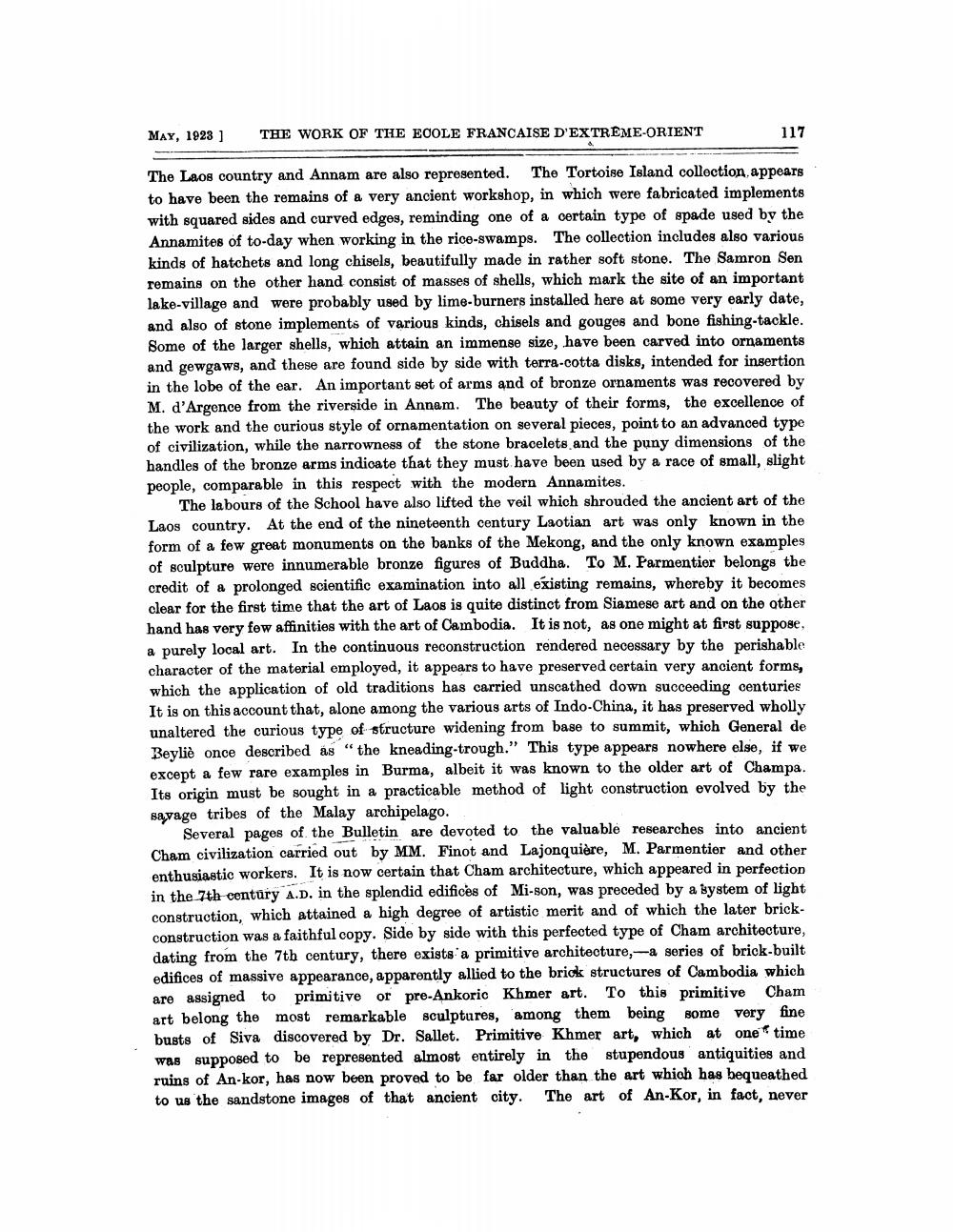________________
MAY, 1923 ]
THE WORK OF THE ECOLE FRANCAISE D'EXTREME-ORIENT
117
The Laos country and Annam are also represented. The Tortoise Island collection appears to have been the remains of a very ancient workshop, in which were fabricated implements with squared sides and curved edges, reminding one of a certain type of spade used by the Annamites of to-day when working in the rice-swamps. The collection includes also various kinds of hatchets and long chisels, beautifully made in rather soft stone. The Samron Sen remains on the other hand consist of masses of shells, which mark the site of an important lake-village and were probably used by lime-burners installed here at some very early date, and also of stone implements of various kinds, chisels and gouges and bone fishing-tackle. Some of the larger shells, which attain an immense size, have been carved into ornaments and gewgaws, and these are found side by side with terra-cotta disks, intended for insertion in the lobe of the ear. An important set of arms and of bronze ornaments was recovered by M. d'Argence from the riverside in Annam. The beauty of their forms, the excellence of the work and the curious style of ornamentation on several pieces, point to an advanced type of civilization, while the narrowness of the stone bracelets and the puny dimensions of the handles of the bronze arms indicate that they must have been used by a race of small, slight people, comparable in this respect with the modern Annamites.
The labours of the School have also lifted the veil which shrouded the ancient art of the Laos country. At the end of the nineteenth century Laotian art was only known in the form of a few great monuments on the banks of the Mekong, and the only known examples of sculpture were innumerable bronze figures of Buddha. To M. Parmentier belongs the credit of a prolonged scientific examination into all existing remains, whereby it becomes clear for the first time that the art of Laos is quite distinct from Siamese art and on the other hand has very few affinities with the art of Cambodia. It is not, as one might at first suppose, a purely local art. In the continuous reconstruction rendered necessary by the perishable character of the material employed, it appears to have preserved certain very ancient forms, which the application of old traditions has carried unscathed down succeeding centuries It is on this account that, alone among the various arts of Indo-China, it has preserved wholly unaltered the curious type of structure widening from base to summit, which General de Beyliè once described as "the kneading-trough." This type appears nowhere else, if we except a few rare examples in Burma, albeit it was known to the older art of Champa. Its origin must be sought in a practicable method of light construction evolved by the savage tribes of the Malay archipelago.
Several pages of the Bulletin are devoted to the valuable researches into ancient Cham civilization carried out by MM. Finot and Lajonquière, M. Parmentier and other enthusiastic workers. It is now certain that Cham architecture, which appeared in perfection in the 7th century A.D. in the splendid edifices of Mi-son, was preceded by a mystem of light construction, which attained a high degree of artistic merit and of which the later brick - construction was a faithful copy. Side by side with this perfected type of Cham architecture, dating from the 7th century, there exists a primitive architecture,-a series of brick-built edifices of massive appearance, apparently allied to the brick structures of Cambodia which are assigned to primitive or pre-Ankoric Khmer art. To this primitive Cham art belong the most remarkable sculptures, among them being some very fine busts of Siva discovered by Dr. Sallet. Primitive Khmer art, which at one time was supposed to be represented almost entirely in the stupendous antiquities and ruins of An-kor, has now been proved to be far older than the art which has bequeathed to us the sandstone images of that ancient city. The art of An-Kor, in fact, never




